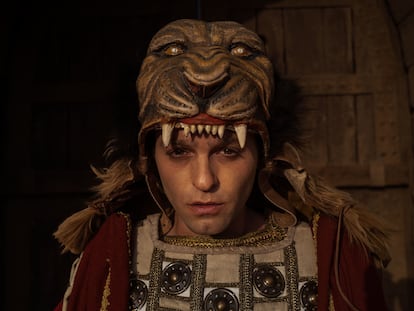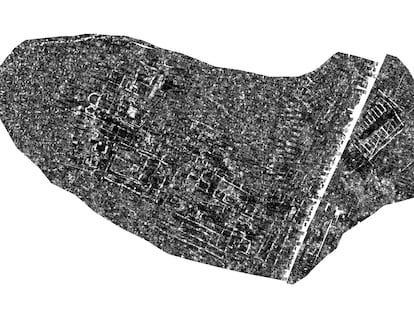Researchers unveil secrets of the largest stash of Roman coins ever found in Spain
The Treasure of Tomares, discovered six years ago, is made up of around 53,000 pieces and was buried in the 4th century under the portico of a villa
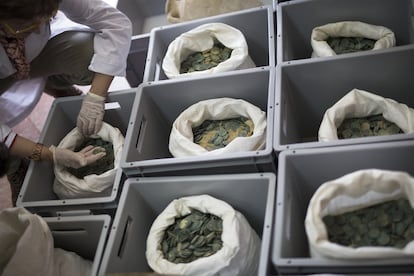

A Civil Guard patrol was the first to arrive at El Zaudín Park in Tomares, in the southern Spanish province of Seville. It was April 27, 2016 and the law enforcement agency had just been notified that heavy machinery doing construction work in the area had accidentally come across 19 large ceramic containers filled with what appeared to be tens of thousands of Roman coins. The excavator bucket had broken 10 of the amphorae, while another nine were saved from the impact and remained intact and sealed. Despite the little information available at the time, the story made international news headlines.
Now, six years later, a group of archaeologists and coin experts from the University of Seville have released a report, Currency and metal in Late Antiquity: the Treasure of Tomares or Zaudín, that explores those findings. After analyzing 5,899 pieces, the researchers concluded that there were approximately 53,000 coins kept in the 19 amphorae, which were buried in a hidden storage area within a now-defunct Roman villa, and that they were all minted between the years 294 and 311 AD. The study also analyzed the possible reasons why their owner concealed them under the portico of the building.
Following the discovery, the amphorae and the coins were immediately taken to the Provincial Archaeology Museum of Seville, where the nine unbroken containers – which are still unopened – were numbered from 1 to 9; the broken ones that still contained coins were labeled with the numbers 10 and 11; while the other eight containers, destroyed and with their contents scattered in the ditch (22,288 coins) received the name of “ordinary collection.” In the following days, technicians returned to the site and recovered another 102 pieces. The Archaeological Institute of Seville, and the University of Seville’s departments of Prehistory and Archaeology, Nuclear Physics and the National Center of Accelerators coordinated efforts to investigate the archeological find.
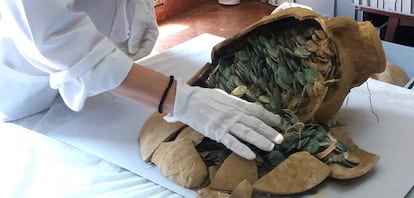
El Zaudín is located in an area of the province of Seville known as El Aljarafe. It is a plateau about a hundred meters high that overlooks the Guadalquivir countryside. Its geographical position and surroundings make this region a territory that has been inhabited since the Chalcolithic; all cultures have passed through here and left their mark through dolmens, a Phoenician sanctuary (El Carambolo) and the Roman city of Híspalis.
The archaeological dig that was carried out after the discovery included a georadar survey and a stratigraphic survey. These techniques documented the remains of a building from between the 3rd and 4th centuries, with excavated walls and buttresses, characteristic elements of hórreos (granaries). The hórreo of El Zaudín was presided over by a portico supported by columns and paved with lime. Research dates the construction of this warehouse to the 1st century and its abandonment to the 4th century, when the treasure was hidden under the portico. Two centuries later, the building was dismantled to reuse its materials, but nobody realized that a treasure lay beneath their feet. Specialists believe that the warehouse was part of a villa that has not been located. The Roman villas were, in reality, large agri-food complexes that included, in addition to the aristocrat’s home, buildings for food production and living quarters for the workers.
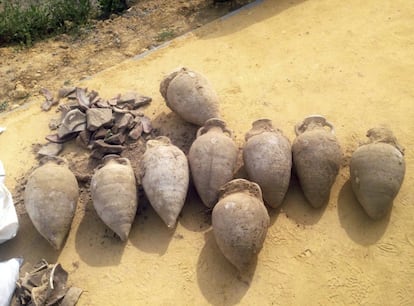
To determine how many coins make up the treasure, it was assumed that all the amphorae contained a similar number of pieces. Fragmented amphorae 10 and 11 – in which the Andalusian Institute of Historical Heritage introduced micro-cameras – each contain 2,800 coins of the same type of alloy. Since all the amphorae are the same size – they were initially used to store oil – it is estimated that there are 53,000 coins. They are pieces issued after the reform of Emperor Diocletian in the year 294 – fiscal, administrative and monetary changes to curb inflation – and there is none that exceeds the year 312.
As the experts only had available the “ordinary collection” for analysis - the coins that had been scattered in the ditch - they chose 3,000 pieces, to which they added 120 collected days later, and another 2,798 from amphora 11, which was broken. In total, they had 5,899 coins ready for study, approximately 10% of the treasure. The report from the University of Seville explains that this was “a sufficient and reliable percentage to make some preliminary observations regarding the composition of the sample that can be extrapolated to the entire set.”
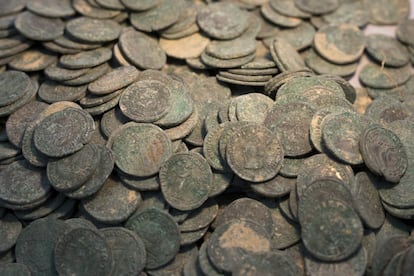
The micro-cameras that were introduced into amphorae 10 and 11 confirmed that the pieces had filled the containers from the bottom to the top, without reaching the neck of the amphorae, where they only found soil, without any remains of a stopper. They were thrown into the vessel loosely, without being grouped in cloth bags. They were thus arranged in superimposed horizontal layers. To avoid air gaps, they were shaken, “which caused the collapse of the peripheral specimens that filled the lateral spaces.” The fact that there is no chronological ordering between the various layers of coins (on the contrary, sometimes the deeper layers are occupied by more recent pieces) confirms the impression that the coins found inside the amphorae were all inserted at the same moment.
The 5,899 pieces that were analyzed were minted under the emperors Diocletian, Maximian, Constantius, Galerius, Constantine, Severus, Maximinus, Licinius and Maxentius. They came from the mints of Rome, Carthage, Aquileia, Treveris, Ticinum, Lugdunum, Londinium, Siscia and Ostia. A smaller number of coins came from Alexandria, Cyzicus, Thessaloniki, Heraklea, Nicomedia and Antiochi. The emperor whose name appears on the highest number of coins is Diocletian, and the mint, Carthage.
This begs the question of why there are more Diocletian-era coins than from any other period of time. The answer could be because as the emperors went by and inflation grew, the weight of the pieces and their percentage of silver fell. In the year 294, a pound of silver was used to mint 32 coins; in 307 this number grew to 40, between 307 and 309 a pound of silver went into making 48 coins, and between 310 and 311, the figure had shot up to 72. In other words, the owner of the treasure preferred to hoard Diocletian’s money, with more silver in it. On average, the coins were made with an alloy of 88% bronze, 4% silver, 3.7% tin and 3.3% lead.
And why so many in the same hands? The researchers explain that Diocletian’s reform triggered “political uncertainty and conflicts between the rulers.” Added to this were territorial and social clashes that would gradually lead to a concentration of property and a devaluation of this type of currency against gold. “These and other factors explain the large amount of coins that were found, as only in large numbers could payments of a certain level be undertaken.” In other words, to make any important financial transaction, a huge number of coins was necessary. And more so if you owned a villa that functioned as an agri-food center.
The Tomares Treasure is one of the largest coin collections from the Tetrarchy (a system of government introduced by Diocletian that involved two emperors and their successors ruling at the same time) in the entire imperial territory. “It is only surpassed in size by that of Misurata, in Libya, and constitutes a top-tier testimony of monetary circulation at the beginning of the 4th century AD in the south of the Iberian Peninsula. Its composition is also an immense archive in which to study the vicissitudes (devaluations, changes in weight) of the economic policy of the emperors of the Tetrarchy, a time when the manipulation of currency was an important economic resource in the hands of public authorities.” In other words, inflation was eating away at Rome’s money, and what better way to deal with it, they figured, than crank out more money of poorer quality?
Tu suscripción se está usando en otro dispositivo
¿Quieres añadir otro usuario a tu suscripción?
Si continúas leyendo en este dispositivo, no se podrá leer en el otro.
FlechaTu suscripción se está usando en otro dispositivo y solo puedes acceder a EL PAÍS desde un dispositivo a la vez.
Si quieres compartir tu cuenta, cambia tu suscripción a la modalidad Premium, así podrás añadir otro usuario. Cada uno accederá con su propia cuenta de email, lo que os permitirá personalizar vuestra experiencia en EL PAÍS.
¿Tienes una suscripción de empresa? Accede aquí para contratar más cuentas.
En el caso de no saber quién está usando tu cuenta, te recomendamos cambiar tu contraseña aquí.
Si decides continuar compartiendo tu cuenta, este mensaje se mostrará en tu dispositivo y en el de la otra persona que está usando tu cuenta de forma indefinida, afectando a tu experiencia de lectura. Puedes consultar aquí los términos y condiciones de la suscripción digital.
More information
Últimas noticias
Most viewed
- Sinaloa Cartel war is taking its toll on Los Chapitos
- Oona Chaplin: ‘I told James Cameron that I was living in a treehouse and starting a permaculture project with a friend’
- Reinhard Genzel, Nobel laureate in physics: ‘One-minute videos will never give you the truth’
- Why the price of coffee has skyrocketed: from Brazilian plantations to specialty coffee houses
- Silver prices are going crazy: This is what’s fueling the rally
